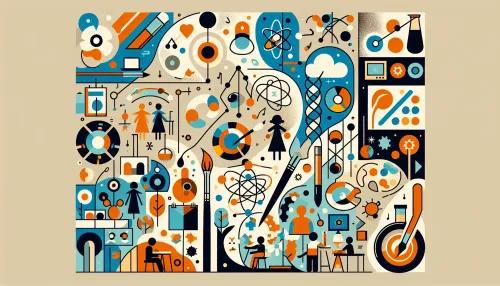
Myth vs. Reality: Unraveling Sensory Sensitivities in Autism

Welcome to the HorizonsMind Blog, where we delve into topics aimed at understanding and supporting individuals with neurodiverse traits. In this article, we will explore the intricacies of sensory sensitivities in autistic children, debunk common misconceptions, and provide insights into empathetic support strategies.
Understanding Sensory Processing Differences in Autistic Children
Autism Spectrum Disorder (ASD) encompasses a wide range of conditions characterized by challenges in social skills, repetitive behaviors, and communication. One aspect that significantly impacts individuals with autism is sensory processing. It's essential to recognize that sensory processing differences vary widely among autistic children. While some individuals may be hypersensitive to certain stimuli, others may seek sensory input.
Sensory processing differences manifest in various ways, including heightened sensitivity to lights, sounds, touch, taste, and smells. For some autistic children, these sensitivities can lead to overwhelming responses and meltdowns in environments that may seem ordinary to others.
Debunking Common Misconceptions About Sensory Sensitivities in Individuals with Autism
There are prevalent misconceptions surrounding sensory sensitivities in autism that often lead to misunderstandings and inadequate support for autistic individuals. One common myth is that sensory sensitivities result from behavioral issues or are mere exaggerations. In reality, sensory processing differences are neurologically based and can have a profound impact on an individual's wellbeing and behavior.
It's crucial to dispel the misconception that individuals with autism can simply "get used to" or "outgrow" their sensory sensitivities. Such beliefs disregard the real struggles faced by autistic children and hinder the implementation of effective support mechanisms.
The Impact of Sensory Overload on Autistic Individuals: Exploring Realities
Sensory overload is a stark reality for many autistic children. Everyday environments inundated with stimuli can become overwhelming, leading to heightened anxiety, distress, and emotional dysregulation. Imagine a bustling classroom with fluorescent lighting, multiple conversations, and tactile sensations from various textures – this amalgamation of stimuli can trigger sensory overload for autistic children.
Understanding the impact of sensory overload is critical for creating inclusive environments that accommodate the specific needs of autistic children. By acknowledging the profound effects of sensory overload, we pave the way for empathetic support systems tailored to individual sensitivities.
Strategies for Empathetic Support Amidst Sensory Overload in Autistic Children
Navigating sensory overload necessitates proactive measures to provide compassionate support to autistic children. An inclusive approach involves creating sensory-friendly spaces that minimize overwhelming stimuli. This may involve dimming lights, providing noise-canceling headphones, or establishing quiet zones where individuals can retreat when feeling overwhelmed.
Furthermore, education and awareness play a pivotal role in fostering understanding among caregivers, educators, and peers. By equipping them with knowledge about sensory sensitivities in autism, we cultivate empathy and empower them to offer meaningful support.
Clearing Misunderstandings Around Sensory Seeking and Avoidance Behaviors in Autism Spectrum Disorder
Sensory seeking and avoidance behaviors are integral manifestations of sensory sensitivities in autism spectrum disorder. It's imperative to dispel misconceptions regarding these behaviors and acknowledge them as valid responses to sensory stimuli rather than mere preferences.
Recognizing these behaviors as coping mechanisms underscores the necessity of tailored interventions that align with an individual's specific sensory needs. It also encourages a shift from stigmatizing these behaviors towards accommodating and respecting them within diverse settings.
Nurturing Understanding: Breaking Down Myths About Sensory Sensitivities in Autistic Children
Nurturing understanding begins with debunking myths surrounding sensory sensitivities in autistic children. Affording individuals with autism the space to express their unique experiences fosters a culture of empathy and acceptance. As advocates for inclusive practices, we must actively challenge misconceptions by amplifying authentic narratives from individuals with autism.
Open dialogues centered on genuine experiences create an environment conducive to destigmatizing sensory sensitivities and promoting awareness within broader communities.
Addressing the Complexities of Sensory Sensitivities: Insights Into Misunderstood Behaviors
The complexities of sensory sensitivities extend beyond surface-level observations, requiring nuanced insights to comprehend the multifaceted nature of these challenges. Addressing these complexities involves reframing perceptions and acknowledging that each autistic child's sensory experiences are profoundly personal and distinct.
By delving into the intricacies of misunderstood behaviors stemming from sensory sensitivities, we gain valuable perspectives that inform holistic support strategies designed to celebrate diversity and honor individual differences within the autistic community.
In conclusion, unraveling the realities of sensory sensitivities in autistic children is a multifaceted journey that demands empathy, education, and introspection. By dispelling myths and embracing diverse perspectives, we foster inclusive environments where every individual feels understood and supported on their unique neurodiverse path. Let's continue amplifying awareness and nurturing understanding for autistic children with sensory processing differences.


